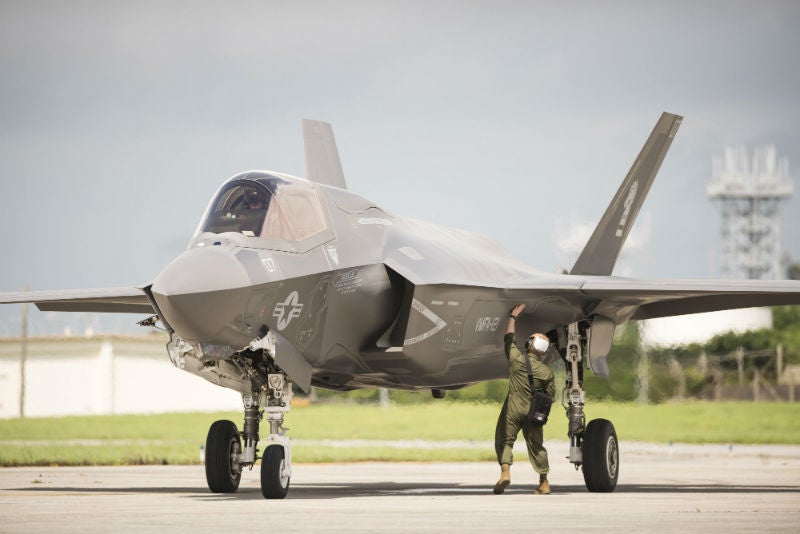
Many of the world’s top defence companies have released fourth quarter (Q4) and full-year financial results for 2018.
The top five companies generally performed well last year, in part due to higher defence spending in the US and elsewhere.
GlobalData head of R&A for aerospace, defence and security Daniel Jones told Army Technology: “The top five US defence firms reaped the benefits of the Trump administration’s largesse in 2018, posting strong full-year results off the back of a rise in defence expenditure to $716bn. In fact, benchmark aerospace and defence funds are up around 10-15% in 2019, which is their best January performance in ten years. This should be seen in context, however, with US stocks overall seeing their best January in thirty years following the market turbulence of December and the about-face guidance from the Fed [federal government].”
“Despite a proposal to increase defence spending to $750bn in 2019, all five companies also gave a cautious outlook for the year ahead citing global trade tensions and rising industrial costs. The major wildcard remains the potential return to defence spending caps in 2020/2021 if the Trump administration is unable to agree on a budget deal with a newly emboldened Democratic party as a result of 2018’s midterm results.”
How did each company perform in their respective defence businesses in 2018?
Lockheed Martin reports lower profits
Lockheed Martin reported on 29 January 2019 that its forecasted profits for this year are to fall below previous estimates, adding that quarterly margins slipped last year at the company’s F-35 fighter jet and C-130 transport plane units.
How well do you really know your competitors?
Access the most comprehensive Company Profiles on the market, powered by GlobalData. Save hours of research. Gain competitive edge.

Thank you!
Your download email will arrive shortly
Not ready to buy yet? Download a free sample
We are confident about the unique quality of our Company Profiles. However, we want you to make the most beneficial decision for your business, so we offer a free sample that you can download by submitting the below form
By GlobalDataIn its aeronautics division, which manufactures F-35s and C-130s, Lockheed’s operating margins fell year-on-year from 11.6% in Q4-2017 to 10.6% for Q4-2018. One of the reasons for the lower margins was greater investment in new aircraft, Lockheed chief financial officer Bruce Tanner told investors, as well as lower sales across its C-130 transport programme.
This year, the company plans to invest up to $1.7bn to enhance its space sector, particularly investing in research and development of hypersonic weapons.
Raytheon’s strong annual net sales
US defence firm Raytheon has announced an increase in its year-on-year net sales for Q4 by 8.5%, from $6.8bn in Q4/2017 to $7.4bn in Q4/2018. Total annual net sales rose from $25.3bn in 2017 to $27.1bn this year.
According to the company, the rise in net sales was driven primarily by operational improvements and lower taxes.
Raytheon chair and CEO Thomas A Kennedy said: “Raytheon had a very successful year in 2018. We accelerated our sales growth yet again and achieved a new company record for operating cash flow. We ended the year with record bookings and backlog, which positions us well for 2019 and beyond.
The 2019 outlook estimates that Raytheon could reach net sales between $28.6bn and $29.1bn by this time next year.
Northrop Grumman exceeds profit estimates
Northrop Grumman has exceeded profit estimates from Wall Street, reporting that adjusted net quarterly profit had risen from $266m to $855m year-on-year from Q4/2017.
The company noted that a 24% rise in sales to $8.16bn led earnings growth, which included top-line growth in sales of its Aerospace business by 6% and Mission Systems by 2%. However, this was partially offset by an 8% decline in sales in Northrop’s Technology Services unit.
Northrop Grumman CEO Kathy Warden said: “Our fourth quarter and full-year financial results, along with our 2019 outlook, demonstrate that we are on a solid growth trajectory. I’m confident we are well positioned to deliver innovative and affordable solutions, with an enhanced degree of agility to create value for our customers and shareholders.”
Northrop Grumman expects its annual net sales to reach $34bn throughout 2019.
Soaring revenue for Boeing’s defence sector
Aerospace giant Boeing announced that all three of its key sectors – defence, space and security – reported high revenues, which combined reached $100bn in 2018.
While its commercial business saw its annual revenue increase by 12% to $17.3bn, Boeing’s defence business achieved a higher 16% rise from last year, to $6.1bn for Q4/2018. In January 2019, Boeing delivered the long-delayed KC-46A aircraft tankers to the US Air Force.
For 2019, Boeing estimates that it will increase its group revenue to $110bn-122bn, equivalent of around 10% rise from the recent results for 2018. However, the company plans to shift costs related to military derivatives of commercial aircraft from the commercial sector to its defence, space, and security sector.
General Dynamics’ revenue grows across the board
In its full-year financial results for 2018, General Dynamics has reported year-on-year revenue growth in all five of its business sectors, including Combat Systems, Mission Systems, and Marine Systems.
Revenue for Q4/2018 grew to $10.4bn, adding to total full-year growth of $36.2bn.
In its Combat Systems division, General Dynamics reported a rise in Q4 year-on-year revenue by 4.9% to $6.2bn. The equivalent rise in revenue for its Mission Systems and Marine Systems divisions was 5.5% and 11.1% respectively from Q4/2017.
Strong results followed on from big contracts in 2018, including the M1A2 Abrams tank upgrades, orders for additional Stryker double-V hull vehicles, and the US Army’s Mobile Protected Firepower programme contract for prototype military vehicles.
In its Mission Systems segment, General Dynamics secured a $3.9bn contract for the US Army’s Common Hardware Systems-5 programme. Key contract awards in the Marine Systems division included a $607m in contract modifications on an existing $6.1bn contract for design and development on the Columbia ballistic missile submarine.







